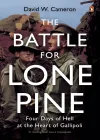The Battle for Lone Pine: Four Days of Hell at the Heart of Gallipoli
Written by: David W. Cameron,
Viking, 2012,
ISBN: 9780143572114, 386 pp
Reviewed by: Dr Karl James, Australian War Memorial
Built on the heart of the old battlefield, Lone Pine Cemetery on Gallipoli Peninsula is today a place of contemplation and reflection. It contains the remains of over 1100 Commonwealth servicemen including 182 Australians killed in the area, mostly during August 1915, and who are known or believed to be buried in the cemetery. The Lone Pine Memorial, which dominates the cemetery, commemorates the nearly 5000 Australians and New Zealanders who died at ANZAC who have no known grave or who were buried at sea. The peaceful- ness of the cemetery contrasts starkly with the brutal violence of the area almost 100 years ago.
Staged as part of the doomed British and Commonwealth forces’ August Offensive, the Australian attack at Lone Pine was intended as ‘a demonstration’, a feint to divert the attention of the Turks from the attacks on the Sari Bair ridge from Hill 971 to Chunuk Bair. From 6 to 10 August 1915, units from the Australian 1st Division captured the Turkish trenches at Lone Pine and withstood repeated attacks to hold much of the newly won ground. Charles Bean, the First World War Australian Official Historian, considered the hand-to-hand fighting at Lone Pine ‘the heaviest of its kind in which Australian troops ever took part’.
The conditions were truly hellish. In trenches held by the 7th Battalion, for example, 26-year-old Corporal Frederick Wright and 24-year-old Corporal Harry Webb ran along the trench trying to catch and throw back the grenades (the Turkish spherical ‘cricket ball’ bombs) thrown into their lines by the Turks or smother the grenades’ fuse with greatcoats and sandbags. Inevitably, Wright was killed when a bomb he caught exploded. A bomb also exploded in Webb’s face. Lieutenant Colonel Harold ‘Pompey’ Elliot saw the mortally wounded Webb try to make his way out of the line: ‘Fancy seeing a man you knew blinded and with both hands blown off trying to get up on his feet … [with his] bleeding shattered stumps held out in front of him.’ Webb died soon afterwards. Both he and Wright are commemorated on the Lone Pine Memorial. Writing to a friend, Elliott described the carnage around him:
When anyone speaks to you of the glory of war, picture to yourself a narrow line of trenches two and sometimes three deep with bodies and think too of your best friends for that is what these boys become by long association with you mangled and torn beyond description by the bombs and bloated and blackened by decay and crawling maggots.
Over the four days of fighting, the Australian 1st Division suffered over 2200 casualties — virtually half of the total number who had launched the attack — and more than 800 killed. Seven Australians were awarded Victoria Crosses during the action. The Turkish toll was estimated at 6000 casualties including some 1500 killed.
It has been argued that the feint at Lone Pine was too successful. The Turkish troops who were sent to reinforce the area were quickly moved to Chunuk Bair to defeat the New Zealand attack once Turkish commanders realised that this was the real objective. Thus the new Australian positions at Lone Pine were exposed to Turkish observation and fire for the rest of the campaign.
Given the vast library that already exists on Gallipoli, it is remarkable that David Cameron’s The Battle for Lone Pine is the first book to be published dealing solely with Lone Pine. Cameron is well suited to write about the battle, having already written several books on the Gallipoli campaign including The August Offensive at ANZAC, 1915 (2011) published as part of the Australian Army Campaign Series.
The Battle for Lone Pine is a detailed — and at times moving — narrative. Concentrating on soldiers’ experiences, Cameron does not shy away from graphic descriptions of combat and the miserable conditions endured by both Australians and Turks. Indeed, Cameron is to be congratulated for including the Turkish perspective in his narrative. The experiences of many men, such as Wright, Webb and Elliot, fill the book’s pages, almost to the point where the number of indi- viduals mentioned becomes a blur. Additional maps, such as those from The August Offensive at ANZAC, 1915 would have complemented the detailed narrative. So too would a more extensive discussion of the strategy behind the August Offensive, examining Lone Pine in its broader context rather than looking at the battle in isolation.
Overall however, Cameron has researched widely to write an engaging narrative of one of the more desperate and futile actions of the Gallipoli campaign. This book is a tribute to those Australians who are commemorated and forever lie buried at Lone Pine.

